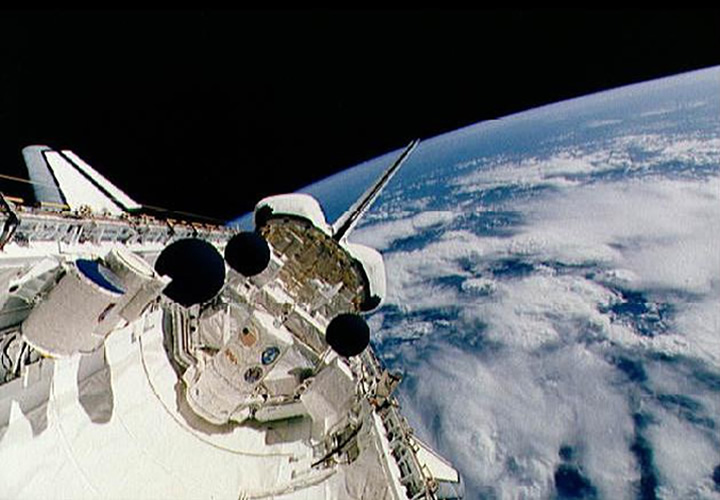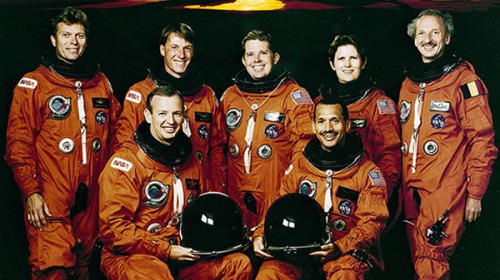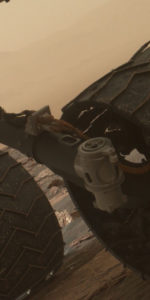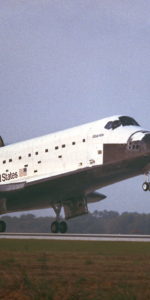
A quarter-century ago, this week, Space Shuttle Atlantis roared into orbit on a mission intensely focused on Planet Earth; a mission which had been in the planning stages for more than a decade and a mission which, but for the tragic loss of Challenger, might have taken place in a slightly different form in mid-1986. STS-45, launched on 24 March 1992, carried the first Atmospheric Laboratory for Applications and Science (ATLAS-1) facility to support myriad investigations into atmospheric chemistry, solar and space plasma physics and ultraviolet astronomy. The nine-day flight was notable in that its seven-strong crew included future NASA Administrator Charlie Bolden in command, as well as Dirk Frimout, who unexpectedly became Belgium’s first national astronaut.
Interestingly, the first crew assignments for an earlier incarnation of ATLAS-1 were made in June 1984, when Byron Lichtenberg and Mike Lampton were named as Payload Specialists for the first Earth Observation Mission (EOM-1), then planned to launch in November 1985. Joining them aboard shuttle Atlantis for Mission 51H were Commander Vance Brand, Pilot Mike Smith—who later lost his life aboard Challenger—and Mission Specialists Owen Garriott, Bob Stewart and European Space Agency (ESA) astronaut Claude Nicollier. For EOM-1, a “short” Spacelab pressurized module and a pallet of hardware would support the reflight of nine solar and space plasma physics, atmospheric physics, astronomy and Earth observations experiments from the Spacelab-1 mission.
Over the next few months, the changeable pre-Challenger shuttle manifest led to a few crew changes, as EOM-1 was canceled and its payloads merged into the EOM-2 flight, with a revised launch date in the summer of 1986. A summertime launch was expected to benefit one of the EOM-1/2 experiments—namely the European-built Metric Camera, mounted in the roof of the Spacelab short module—which would offer an improved probability of good weather over primary land masses in the Northern Hemisphere. In the meantime, Smith was reassigned to a new mission and replaced, in September 1985, by Dave Griggs. Three months later, U.S. physicist Charles “Rick” Chappell and Belgian physicist Dirk Frimout were named as backups to Lichtenberg and Lampton.

All that changed on 28 January 1986, when Challenger exploded, shortly after liftoff, and the entire shuttle program was grounded for almost three years. During that interval, recommendations from the presidential investigation led to the formulation of new NASA strategies, including the “Mission to Planet Earth”. As the shuttle returned to flight, EOM was reborn as ATLAS. The Spacelab short module was removed from the payload and replaced by a pair of pallets and associated electronics to handle the science output. Original plans called for up to ten ATLAS missions, launched every 12-18 months, to characterize solar activity across an entire 11-year cycle, as well as monitoring atmospheric change over the long term. Dovetailed into these plans was a comprehensive effort to assess humanity’s impact on its home world.
In September 1989, veteran NASA astronaut Kathy Sullivan and British-born Mike Foale were assigned as Mission Specialists for the ATLAS-1 mission, then scheduled for launch aboard shuttle Columbia on STS-45 in March 1991. Remaining from the original EOM-1/2 flight were Lichtenberg and Lampton as Payload Specialists, backed up by Chappell and Frimout. By the middle of the following year, they had been joined by Commander Charlie Bolden, Pilot Brian Duffy—a future Astronaut Hall of Fame (AHOF) inductee—and Mission Specialist Dave Leestma. However, technical troubles which affected the entire shuttle fleet throughout the summer of 1990 caused a domino-like impact on downstream missions. STS-45 found its launch date moving further to the right, eventually into early 1992. The mission was also shifted from Columbia onto her sister shuttle, Atlantis.
Then, in September 1991, Lampton was abruptly removed from the flight, due to a medical issue, and replaced by Frimout. In her NASA oral history, Sullivan recounted that Lampton’s ailment began in December 1990, but as he “got life-threateningly ill” over the next few months, a senior-level decision was made to replace him. It hit the close-knit STS-45 crew very hard. As the Payload Commander, Sullivan was in overall charge of the scientific research and she remembered the cross-evaluation which led to the assignment of Frimout to Lampton’s place. “Both very competent,” she said of the two physicists. “There wasn’t really any high-level distinguishing factor there.”
After a one-day delay from 23 March 1992, due to higher than allowable concentrations of liquid hydrogen and oxygen in the shuttle’s aft compartment, the STS-45 crew headed out of the Operations & Checkout (O&C) Building around 5 a.m. EDT on the 24th, bound for Pad 39A. Launch occurred at 8:13 a.m. and Atlantis rocketed perfectly into space, with Bolden later expressing admiration for the performance of his crew, three of whom had not flown before. “We had a running dialog going,” he remembered. “Brian was kinda calling out Mach-numbers and altitude and I would try to throw in something every once in a while, but in checking with the folk down on the middeck, everybody seemed to be quite away of what was going on. That was a comforting feeling, as a Commander, to know that everybody was alert and ready to get going.”
From his seat on the right-hand side of the cockpit, Duffy was impressed by “just how much raw power there is in that vehicle”. His years in the shuttle simulator had taught him to expect the vibrations and motions, but nothing had given him the sense of immense acceleration. “You can think about what it might be like,” he said later, “but you don’t actually physically feel it until you go do it. I had flown Mach 2 in an F-15 in my career—many times—and had thought that had been pretty fast…and we blew through Mach 2 in nothing flat and we still had a long way to go to accelerate!”
As the twin Solid Rocket Boosters (SRBs) separated, at two minutes into the ascent, Duffy noticed that the exhaust of their forward separation motors left some “glazing” on Atlantis’ cockpit windows. This later burned away during re-entry. With the boosters gone, the vehicle continued to climb, under the impulse of the three Space Shuttle Main Engines (SSMEs), and although there were few “good” visual references, it was obvious to Duffy that their velocity was immense. Every few seconds, he would glance at the acceleration tapes on the instrument panel and be astonished as they zinged higher and higher up the scale.
This controlled violence came to an abrupt end at eight minutes, when the SSMEs were shut down, precisely on time, and everything fell deathly silent aboard Atlantis. “You go from the most violent place you’ve ever been in your life,” Duffy later reflected, “to the most peaceful place you’ve ever been in your life…in a couple of seconds!”
And backdropped by the serenity of this peaceful place, STS-45 was underway.
The second part of this article will appear tomorrow.
Be sure to “LIKE” AmericaSpace on Facebook and follow us on Instagram & Twitter!





